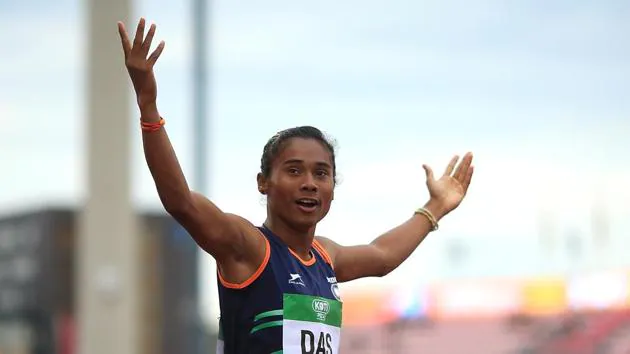Most Indian women athletes face hurdles — from gender bias (girls can’t play; it’s unseemly; they will become dark) to lack of opportunity. In many cases, they must also grapple with poverty

In many cases, Indian women athletes must grapple with poverty. Hima Das, who brought home four gold medals in 15 days, is the daughter of a farmer(Getty Images for IAAF)
As Monika Kumari begins a two-week, all-female scientific wilderness expedition to Mount Baker, an active volcano, in Washington, USA, she might want to consider the distance she ha s come.
Hutup village, Jharkhand, where she lives, is over 11,500 km away. But the terrain that this 16-year-old daughter of a security guard has travelled is long and hard. When she first showed her outdoor spirit, playing football as a six-year-old, relatives and neighbours scoffed: Who had ever heard of girls wearing shorts and playing sport? Moreover, if girls started goofing off at play, who would do the housework?
She stuck it out. Today, she continues playing football and earns money by coaching younger girls at the Yuwa camp. “In my village, girls don’t get many opportunities to follow their dreams,” she says. Monika’s younger brother, the only son, is named Golden, reflecting perhaps the sheen of his father’s aspirations.
Supported by BookASmile, Yuwa works with girls from impoverished, mainly tribal, families in rural Jharkhand and was set up by Franz Gastler, an American who came to India as a business consultant in 2007, visited a village near Ranchi on work, and never went back.
Starting with just 11 girls, Yuwa now runs a school, and coaches 470 girls who are trained by 43 coaches, most of them women. Through football, education and mentorship, the girls, “work as a team, gaining confidence, camaraderie and community,” Gastler tells me on the phone. The girls practice six days a week, travel and compete in tournaments, and have become role models. Goalkeeper Monika has been to Spain to play, twice.
It is not easy. “The girls get a lot of pushback from their families, especially after they hit puberty,” says Gastler. They face harassment on the street when they step out in shorts and some are even beaten at home for daring to play.
Most Indian women athletes face hurdles — from gender bias (girls can’t play; it’s unseemly; they will become dark) to lack of opportunity. In many cases, they must also grapple with poverty. Hima Das, who brought home four gold medals in 15 days, is the daughter of a farmer. Swapna Barman, who won India’s first heptathlon gold at the 2018 Asian games, is the child of a handcart puller.
Slowly, these girls are breaking the stereotype of an impoverished girl’s life in rural India. Jharkhand does poorly on many gender counts. It has the most cases of human trafficking and child marriage in the country. Only 59% of women are literate, below the national average of 68.4%, according to the National Family Health Survey-4, 2015-16.
Sport has given her confidence. When Monika’s dad wanted to marry off her elder sister right after her 10th boards, Monika along with her mother was able to convince him to postpone the marriage for a bit. The sister is now enrolled in an IT course.
Namita Bhandare writes on social issues
The views expressed are personal